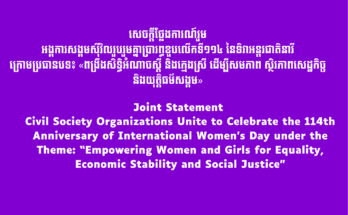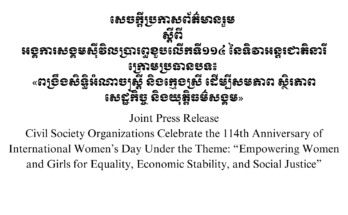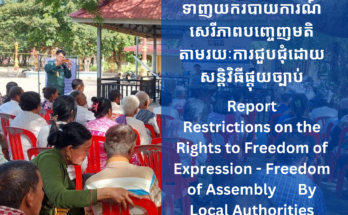February 3, 2016
This decade marks a radical shift in the Association of Southeast Asian Nations (ASEAN) member states’ attitudes toward its role in the region. The idea of an ASEAN regional peacekeeping cooperation was first raised in 1994, but never gained traction among member states. The perception was that ASEAN did not interfere in domestic affairs of its member countries.

Sub-national conflicts in countries like Thailand are raising concerns about the spillover potential to other countries, and the need for a common peacekeeping for for the region.
Fast forward two decades, in the lead up to the establishment of the ASEAN Community in 2015, and the picture is a very different one. Malaysia reinvigorated the push to create a regional peacekeeping force and over the past year, member states have become increasingly supportive. However, there are still some hurdles.
ASEAN’s changing attitudes toward a common peacekeeping force
States initially opposed the idea of an ASEAN peacekeeping force because of their shared history of colonization (with the exception of Thailand), followed by bloody and protracted independence wars. Sovereignty and non-interference became the bedrock of many member states and founding principles enshrined in the ASEAN charter. Instead of pushing for an active regional peacekeeping force, ASEAN opted for a “third way:” conflict management based on consensus and consultation.
In 2003, Indonesia raised the issue again, suggesting that ASEAN adopt a peacekeeping force to address the increasing number of intra-state conflicts across Southeast Asia with spillover potential to neighboring countries. Indonesia’s candid support for a force emanated from its growing contribution to the UN peacekeeping operation, driven by Indonesia’s desire to strengthen its democratic image abroad as well as to provide a bigger, more international role for its inactive military.
However, some countries, including Vietnam, opposed a force in part due to historical distrust of multilateral organizations such as the UN and ASEAN. Vietnam argued that a force could infringe state sovereignty – of particular importance given the country’s experience with some of the most ferocious conflicts against foreign powers in modern history.
Other countries joined the chorus of skepticism. Thailand’s Minister of Foreign Affairs, Surakiart Sathirathai, said that “there was no conflict in the region that would force.” Syed Hamid Albar, a former government minister in Malaysia, argued that ASEAN is not a “military block” and that a force would not be useful in spurring economic growth or counteracting natural disasters. Indonesia’s proposal was rejected.
Yet in recent years, attitudes have changed dramatically. Malaysia has u-turned and is currently rallying member states to adopt a regional force. Countries that previously opposed or expressed reservations to such a force are now supporting it. Changing policies to international peacekeeping have been most visible in Vietnam, which amended its constitutional ban in 2014 on deploying armed forces for UN peacekeeping missions. Vietnam launched a Peacekeeping Training Center the same year. Similarly, Cambodia first mentioned peacekeeping in the Cambodia Defence White Paper in 2006. Since then, it has deployed more than 1,600 peacekeepers abroad and has expressed support for Malaysia’s regional peacekeeping initiative. The reason for this are two-fold: the increasing participation in UN peacekeeping operations of individual member state and the changing nature of global challenges.
Firstly, the growing role of many ASEAN states in international peacekeeping has made them more aware of the benefits of acting multilaterally to address transnational challenges. For example, Vietnam, after its constitutional amendment, deployed military engineers to join the mission in Mali, which was widely lauded by the international community, boosting international support for the Vietnamese government.
Secondly, regional challenges facing Asia today have also changed leading to a reconsideration of the benefits of having a regional force. These include the migrant crisis involving Bangladeshi and Rohingya boat people; the terrorist attacks in Bangkok and, more recently, Jakarta; and the simmering subnational conflicts in Thailand and the Philippines that have potential to spill across borders. The South China Sea dispute, subnational conflicts, and humanitarian disasters in Aceh and Myanmar are some of the most prominent factors driving Malaysia to initiate a peacekeeping force. For instance, Malaysia facilitated peace talks in Thailand and in the Philippines, though found it difficult to portray itself as neutral when rebel groups conflated Malaysia’s facilitating role with its inter-state relations with the respective governments. Thus, Malaysia believed that a multilateral regional peacekeeping force would more likely build trust between rebel groups and ASEAN third parties as well as between individual member states to achieve peace.
Hurdles to a peacekeeping force
While attitudes have shifted, ASEAN’s modus operandi has not. Structural hurdles could render a regional peacekeeping force, if set up, irrelevant and inefficient. If these existing hurdles persist, regional efforts will have a limited impact in resolving conflict and preventing attacks.
ASEAN still suffers from highly disparate socioeconomic capacities, thematic priorities, and levels of connectedness among its members. These prevent ASEAN from forging a shared perception on security matters. States are still trying to figure out whether an expanding China, subnational conflicts, or radical terrorists represent the biggest security threat to the region.
How would an ASEAN peacekeeping force balance collective responsibility for security with national sovereignty? Who would finance it? How will ASEAN overcome the different levels of connectedness between states, to effectively deploy troops? The heterogeneous background has made it difficult for member states to genuinely reconcile their differences to effectively mobilize a peacekeeping force.
ASEAN states have avoided developing institutional structures that might infringe their autonomy and sovereignty. In contrast to the European Union, ASEAN does not have an effective executive body. Existing agreements are nonbinding and reached through consensus and consultation, which in practice would severely limit the role of a regional peacekeeping force. Such inefficiency circles back to the issue of heterogeneous interests and needs, which have aroused distrust among member states. For some, an ineffective ASEAN would be beneficial to safeguard issues of national interest.
Putting ASEAN to the test
These constraints have hobbled ASEAN’s ability to respond to disasters, such as cyclone Nargis in 2008 which resulted in 138,000 deaths and the displacement of 1.5 million. Myanmar’s government lacked the capacity to deliver basic necessities and ameliorate the human catastrophe yet blocked desperately needed aid from international agencies. Allowing ASEAN to play a prominent role in coordinating aid provided a way out of the stalemate.
ASEAN’s image as a neutral and representative force as well as its unprecedented diplomatic pressure on Myanmar provided it and the international community access to the country. ASEAN prevented the dire humanitarian situation from deteriorating. Yet, the mobilization of the Emergency Rapid Assessment team was painfully slow and uncoordinated because ASEAN was and still is dependent on resources being provided by others, such as individual member states, the World Bank, and the UN.
It is still unclear what ASEAN’s peacekeeping force would look like and what role it will play in the ASEAN Community era. One thing is certain: the security challenges it will face are ever-changing and cross-national. Renewed interest in a peacekeeping force is a big step forward. But, there is still a lack of political will among member states to reform ASEAN’s institutions and make them more powerful. As such, pledges to establish a peacekeeping force are tantamount to putting the cart before the horse.
Victor Bernard is a program associate of The Asia Foundation in Thailand. He can be reached at victor.bernard@asiafoundation.org. The views and opinions expressed here are those of the author, not those of The Asia Foundation or its funder.
Source: http://asiafoundation.org/in-asia/2016/02/03/is-it-time-for-a-peacekeeping-force-for-asean/



